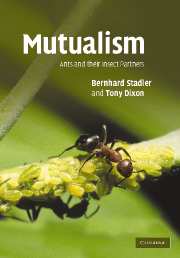6 - Multitrophic-level interactions
Published online by Cambridge University Press: 13 August 2009
Summary
Mutualism within a resource-tracking framework
Bottom-up and top-down forces
Interacting populations are subject to a host of biotic and abiotic factors, no matter whether the result of this interaction is obligate or facultative, positive or negative for the members of one or both populations. This is not new. Trophic relationships were included in the debate about the importance of resources (bottom-up) versus natural enemies (top-down) in determining population size and community structure. In addition, this food web perspective touches upon a century-old issue in ecology, which is the population regulation paradigm (Turchin 1999). This fundamental concept in ecology states that demographic density dependence is the key mechanism for population regulation. The simplest model of regulation is the logistic equation (Verhulst 1838) (for a full historical account see Kingsland 1995, Hixon et al. 2002). It is evident that natural populations do not grow unchecked, yet if and how population regulation occurs still remains an issue treated in special features in major ecological journals (Graham and Dayton 2002) and periodically resurfaces in skirmishes (Murray 1999, Turchin 1999). For example, in their highly influential paper Hairston et al. (1960) argued that in terrestrial communities, decomposers, producers and predators are resource limited ‘in the classical density dependent fashion’, while herbivores are controlled by predation; that is, they are unlikely to compete for resources. Not all agreed then and now (Power 1992, Dixon 2005).
- Type
- Chapter
- Information
- MutualismAnts and their Insect Partners, pp. 107 - 174Publisher: Cambridge University PressPrint publication year: 2008



